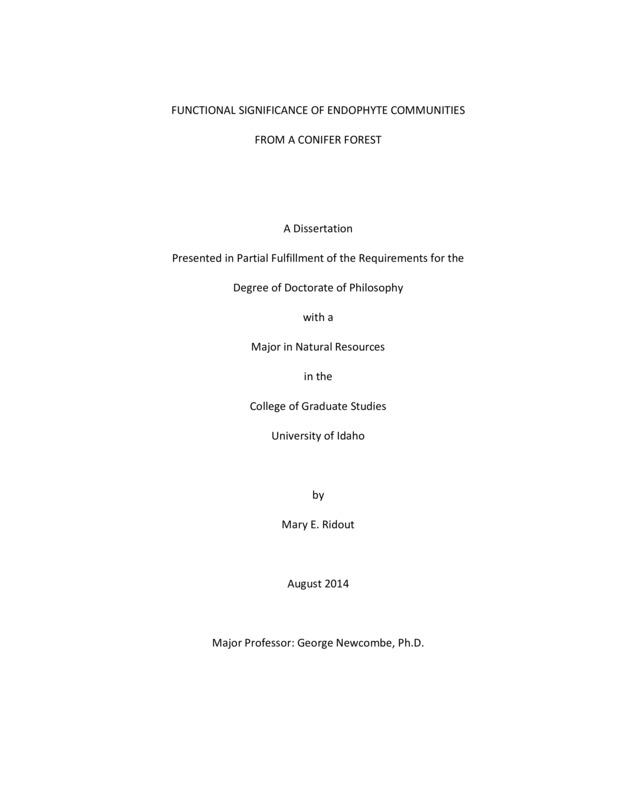FUNCTIONAL SIGNIFICANCE OF ENDOPHYTE COMMUNITIES FROM A CONIFER FOREST
Ridout, Mary E.. (2014). FUNCTIONAL SIGNIFICANCE OF ENDOPHYTE COMMUNITIES FROM A CONIFER FOREST. Theses and Dissertations Collection, University of Idaho Library Digital Collections. https://www.lib.uidaho.edu/digital/etd/items/ridout_idaho_0089e_10385.html
- Title:
- FUNCTIONAL SIGNIFICANCE OF ENDOPHYTE COMMUNITIES FROM A CONIFER FOREST
- Author:
- Ridout, Mary E.
- Date:
- 2014
- Keywords:
- Dothistroma Endophytes Janzen-Connell Microbiome Symbiosis Wheat
- Program:
- Natural Resources
- Subject Category:
- Forestry; Plant pathology; Plant sciences
- Abstract:
-
The microbiome of the conifer forest may be functionally significant in forest hosts, the forest itself, and in agricultural fields converted from forests and woodlands. To assess functional significance of the forest microbiome, we examined within-microbiome interactions, interactions of microbiomes with the host, and the effects of microbiome-host interactions in both natural and managed systems. To determine the effects of within-microbiome interactions on
Dothistroma needle blight in Pinus ponderosa , we inoculated non-pathogenic endophytes from P. ponderosa into emerging needles of Dothistroma -infected trees. Four of six endophytes enabled the pathogen by increasing disease severity as much as 4.7% while one endophyte antagonized the pathogen, reducing severity of the disease by 7%, indicating the potential of non-pathogens interact with pathogens within the microbiome. We then examined the potential function of the microbiome of Pinus ponderosa in conspecific recruitment by inoculating P. ponderosa seed with endophytes of mature conspecifics prior to germination. Endophytes from P. ponderosa reduced germination and emergence of conspecific seed. A needle endophyte showed the strongest inhibitory effects, reducing emergence by as much as 67% indicating foliar endophytes in the litter microbiome may contribute to beta diversity of conifer forests. Finally, to determine whether the conifer microbiome might be significant to the success of winter wheat production in converted woodlands, we conducted a series of experiments to study the potential of the microbiome to mediate disease resistance and stress tolerance in hard red winter wheat. The whole microbiome of pine litter was most effective for suppression of Fusarium culmorum , reducing plant mortality and increasing biomass of Fusarium -infected plants by over 67% compared to untreated plants. Forest endophytes significantly increased root development during vernalization of wheat seedlings. A root endophyte from the microbiome of Pseudotsuga menziesii var. glauca doubled the yield of Fusarium -infected wheat subjected to water stress, indicating that the microbiome of the pine woodlands may have facilitated the success of dryland wheat production in the Pacific Northwest, USA. On-going research promises to expand our knowledge and understanding of the functional significance of the conifer forest microbiome. - Description:
- doctoral, Ph.D., Natural Resources -- University of Idaho - College of Graduate Studies, 2014
- Major Professor:
- Newcombe, George
- Committee:
- Coleman, Mark; Cook, Stephen P; Davis, Anthony S
- Defense Date:
- 2014
- Identifier:
- Ridout_idaho_0089E_10385
- Type:
- Text
- Format Original:
- Format:
- application/pdf
- Rights:
- In Copyright - Educational Use Permitted. For more information, please contact University of Idaho Library Special Collections and Archives Department at libspec@uidaho.edu.
- Standardized Rights:
- http://rightsstatements.org/vocab/InC-EDU/1.0/

